Car audio systems can transform your driving experience from ordinary to extraordinary. A component that many drivers overlook sits at the heart of many high-quality car audio setups: the preamp. This essential device plays a crucial role in delivering clean, powerful sound throughout your vehicle. Let’s dive into the world of car audio preamps and discover why they might be the missing piece in your sound system puzzle.
Contents
- Understanding Car Audio Preamps
- How Preamps Differ From Amplifiers
- Types of Car Audio Preamps
- Key Benefits of Using a Quality Preamp
- Features to Look For in a Car Audio Preamp
- Installing a Car Audio Preamp
- Common Preamp Issues and Solutions
- Preamp Settings for Optimal Sound
- Is a Preamp Worth the Investment?
- Conclusion
Understanding Car Audio Preamps

A car audio preamp (preamplifier) serves as the control center for your audio system. It takes the low-level audio signals from your head unit and processes them before sending them to the amplifier. Think of it as the middle manager between your stereo and your power amplifier, making crucial decisions about how your music sounds before it reaches your speakers.
The preamp handles several vital functions: it boosts weak signals to a level that your amplifier can work with, controls volume, balance, and tone, and helps reduce noise and distortion. Without a good preamp, even the most expensive speakers and amplifiers might not deliver their full potential.
How Preamps Differ From Amplifiers
Many car audio enthusiasts confuse preamps with amplifiers. While they work together, they serve different purposes. The preamp processes and refines the audio signal, while the power amplifier increases the strength of that signal to drive your speakers.
Preamps operate at “line level” – handling the subtle details and nuances in your music before amplification. They don’t provide the raw power needed to move speaker cones; that’s the amplifier’s job. Instead, they focus on signal quality, helping to preserve musical detail and clarity before the amplifier boosts the signal.
Types of Car Audio Preamps
Car audio preamps come in several configurations to match different system needs:
Integrated Preamps: These are built into your head unit (car stereo) and provide basic signal processing. Most factory and entry-level aftermarket head units include integrated preamps with limited features.
External Preamps: Standalone units that offer superior sound processing compared to integrated options. These connect between your head unit and amplifier, giving you enhanced control over your audio.
DSP Preamps: Digital Signal Processors combine preamp functions with advanced digital processing. They offer precise equalization, time alignment, crossover settings, and can even correct vehicle-specific acoustic problems.
Equalizer Preamps: These focus on frequency adjustment, allowing you to fine-tune different frequency bands for customized sound.
Each type offers different levels of control and sound quality improvement. Your choice depends on your budget, space constraints, and how much customization you want over your car audio experience.
Key Benefits of Using a Quality Preamp
Adding a dedicated preamp to your car audio system brings several advantages that enhance your listening experience:
Improved Signal Quality: A good preamp cleans up the audio signal, reducing noise and distortion that can creep in between your head unit and amplifier. This results in clearer, more detailed sound reproduction.
Better Volume Control: Quality preamps offer smoother, more precise volume adjustment without introducing noise at low volume levels.
Enhanced Tonal Balance: Preamps allow you to adjust frequency response more accurately, helping overcome acoustic challenges in the car environment.
System Flexibility: With a dedicated preamp, you gain more options for system expansion and component integration, making future upgrades easier.
Optimized Amplifier Performance: By sending a clean, properly-matched signal to your amplifier, a preamp helps your power amp operate more efficiently and effectively.
Car interiors present unique acoustic challenges with their irregular shapes, reflective surfaces, and background noise. A quality preamp helps overcome these obstacles by giving you the tools to shape your sound precisely.
Features to Look For in a Car Audio Preamp
When shopping for a preamp, several key features can make a big difference in performance:
Signal-to-Noise Ratio (SNR): Higher numbers (measured in dB) mean less background noise. Look for preamps with SNR ratings of 95 dB or higher for cleaner sound.
Total Harmonic Distortion (THD): Lower percentages indicate less distortion. Quality preamps typically offer THD below 0.05%.
Input/Output Options: More connections mean greater flexibility. Check for multiple inputs (RCA, optical, digital) and outputs to accommodate your system.
Equalization Capabilities: Look for detailed EQ controls that let you adjust multiple frequency bands to match your vehicle’s acoustic properties.
Crossover Settings: Adjustable crossovers let you direct specific frequencies to appropriate speakers, improving system performance.
Gain Control: Precise gain adjustment helps match signal levels between components for optimal sound without distortion.
Build Quality: Solid construction with quality components reduces interference and ensures longevity, especially important in the vibration-prone car environment.
A preamp with these features gives you the tools to extract the best possible performance from your car audio system, regardless of your vehicle’s acoustic properties.
Installing a Car Audio Preamp
Adding a preamp to your system requires some planning but isn’t overly complex. The basic installation process involves:
Location Selection: Mount your preamp in a dry, cool location away from heat sources and interference. Many installers place preamps under seats, in trunks, or behind dash panels.
Power Connection: Connect to a clean 12V power source, ideally directly from the battery with appropriate fusing. Ground connections must be solid and secure.
Signal Routing: Run RCA cables from your head unit to the preamp inputs, then from the preamp outputs to your amplifier. Keep these cables away from power wires to prevent noise.
Control Setup: Some preamps include remote controls or display units that need mounting within driver reach.
Configuration: Once physically installed, you’ll need to set gains, crossover points, and EQ settings – a process that takes time but yields tremendous sound quality benefits.
For complex installations involving digital processors or multiple amplifiers, consider consulting a professional installer who can ensure optimal system integration and performance.
Common Preamp Issues and Solutions
Even quality preamps can sometimes introduce problems. Here are common issues and their fixes:
Noise/Hum: Often caused by ground loops or interference. Solutions include checking ground connections, using higher quality cables, and ensuring proper wire routing.
Distortion: May occur from improper gain settings. Recalibrate your gains starting from the lowest setting and gradually increasing until just before distortion begins.
Low Output: Check all connections and settings, particularly input sensitivity switches that might not match your head unit’s output level.
Unbalanced Sound: May require adjustments to EQ, balance, and fader controls. Take time to calibrate these settings carefully.
Technical Glitches: Some digital preamps may need firmware updates or occasional resets to resolve processing issues.
Most problems stem from installation errors rather than equipment failure. Taking time during installation to plan cable routing, secure connections, and calibrate settings properly prevents many common issues.
Preamp Settings for Optimal Sound
Getting the most from your preamp requires understanding and properly adjusting several key settings:
Gain Structure: Start with all gains at minimum. Set your head unit to about 75% volume, then gradually increase preamp gain until you hear distortion, then back off slightly.
Crossover Points: Set these based on your speakers’ capabilities. Typical settings might include low-pass filters at 80Hz for subwoofers and high-pass filters at 80-100Hz for main speakers to prevent distortion.
Equalization: Begin with flat EQ (no boost or cut), then make small adjustments based on what you hear. Car interiors often need cuts in the 200-300Hz range to reduce muddiness and slight boosts in the 10kHz+ range for clarity.
Time Alignment: If your preamp offers this feature, measure the distance from each speaker to the driver’s head position and enter these values to ensure sounds from all speakers arrive at your ears simultaneously.
Sound Staging: Use balance and fader controls alongside other settings to create a sound stage that appears to be in front of you at dashboard level rather than at your feet.
Remember that optimal settings vary depending on your specific vehicle, speakers, and personal preferences. Patience during the tuning process yields significant rewards in sound quality.
Is a Preamp Worth the Investment?
The value of adding a preamp depends on your audio priorities. For casual listeners using factory systems, a preamp might be unnecessary. However, if you’re investing in aftermarket speakers, amplifiers, or subwoofers, a quality preamp becomes increasingly valuable.
Entry-level external preamps start around $50-100, while sophisticated DSP units can cost $300-800+. This investment makes the most sense when:
- You’ve upgraded other components but still aren’t satisfied with sound quality.
- Your vehicle has challenging acoustic properties
- You want precise control over your audio
- You’re building a complex system with multiple amplifiers
- You appreciate subtle details in music reproduction
Many audio enthusiasts find that adding a quality preamp makes a more noticeable improvement than spending the same amount on other components. It’s the “brain” of your system, ensuring all other parts work together optimally.
Conclusion
A car audio preamp serves as the critical link between your music source and your amplification system. By cleaning up signals, providing crucial adjustments, and ensuring ideal matching between components, it fundamentally impacts every aspect of your listening experience.
Whether you’re troubleshooting sound quality issues or building a competition-level system, understanding preamps helps you make informed decisions about your car audio setup. The right preamp matched with proper installation and careful tuning can transform your daily commute into an immersive concert experience.
With various options available from simple tone controls to sophisticated digital processors, there’s a preamp solution for every budget and need. As you plan your next car audio upgrade, consider whether this often-overlooked component might be the key to unlocking your system’s full potential.






